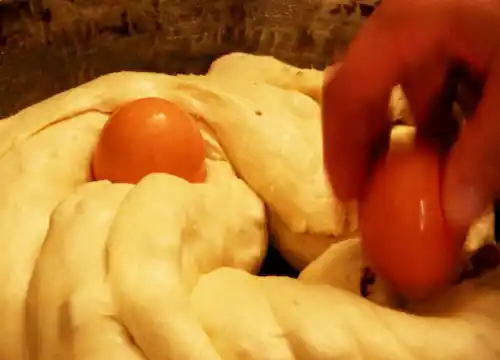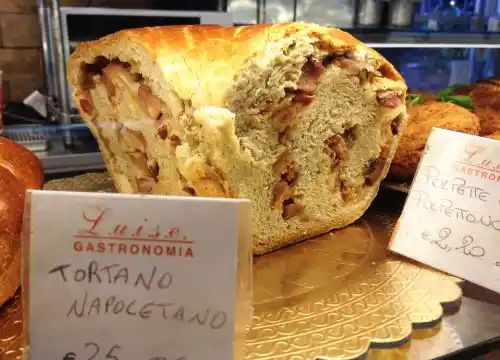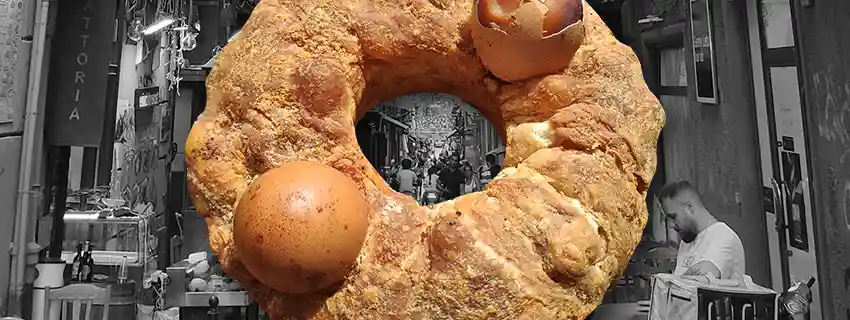Published:
Author: Antonio Maria Guerra
Neapolitan Casatiello
THE ORIGINS OF THE EASTER SAVORY BREAD

Although there are no certainties about it, some experts speculate that the history of casatiello, the famous Neapolitan savory cake, could be very ancient, dating back to classical times. In this article, we will explore the origins of a specialty that, also thanks to its rich religious symbolism, has become a must on the Easter tables in the shadow of Vesuvius. All of this, as always, will be seasoned with interesting information and tasty curiosities. Happy reading!

The history of casatiello.
Tasting a slice of Casatiello it’s possible to understand, at least in part, its origins: the specialty is distinguished by a taste not very complex, but at the same time full-bodied and addictive, betraying a close connection with the peasant culture. A culture in which, since time immemorial, nothing should go wasted: something that, rather than limiting, pushes the invention of new recipes.
For their part, historians cannot pinpoint with certainty the date of birth of this savory cake, whose ancestor may date back to classical times, when the ancient Romans ate the so-called panis adipatus: a flatbread enriched with pork lard.
We know for sure that one of the earliest written records relating to casatiello date back to the XVII Century: it’s a popular fable, the ‘Gatta Cenerentola’ (*1), written by the Neapolitan intellectual Giambattista Basile, in which the author, sketching a sumptuous banquet, refers to a large number of ‘Casatielle’ (*2).
Over time, the tasty delicacy became increasingly related to Easter, reflecting its symbolism in many exterior details, ranging from its shape to the presence of eggs.

Modernity and fashion seem not to have undermined what, over time, has become a true classic in the culinary tradition of the ‘city of the sun’.
Note:
*1: A tutti gli effetti antesignana dei celebri racconti di Hans Christian Andersen e dei fratelli Grimm.
*2: Si riporta per interi il passaggio che include la citazione: “E, venuto lo juorno destinato, oh bene mio: che mazzecatorio e che bazzara che se facette! Da dove vennero tante pastiere e casatielle?”
Naples, the city of Casatiello.
One of the greatest attractions of Naples is undoubtedly its culture, which has its roots in the distant past when the city was called Neapolis and became one of the most flourishing colonies of Magna Graecia. Its culinary tradition is the fruit of this huge wealth of knowledge: among its many gems, it’s important to remember the Casatiello, a specialty that, thanks to its taste, succeeds in representing the cheerful, convivial, and welcoming spirit that characterizes the local people.



Casatiello: the religious references.
In Naples, casatiello is one of the Easter specialties par excellence, served during the abundant meals that dot this holiday. It should come as no surprise, therefore, that it is rich in symbolic religious references, among which are:
- The eggs: the presence of eggs, placed like jewels on the surface of the specialty, refers to themes dear to Christianity, namely resurrection and life after death;
- The ring: the circular shape of the casatiello, similar to a ‘donut’, refers to an idea of infinity and eternal life;
- The cross: the position of the strips placed on top of the eggs reminds the shape of the cross;
- The filling: the richness and taste of the filling hints at an idea of abundance and prosperity;
- The yeast: the use of yeast, evidenced by the growth of the dough, hints at an idea of spiritual progress and transformation;

The history of casatiello: the origins of the name.
Among the many hypotheses regarding the origins of the name ‘Casatiello’, the one currently considered most convincing has it derived from the Latin word ‘caseus’, which, translated in English, means ‘cheese’. So, it is no coincidence that cheese itself is among the main ingredients of the specialty.


Panino Napoletano: the miniature casatiello.
‘Panino napoletano’ (‘Neapolitan sandwich’), also known as ‘pagnottiello’ or ‘pagnuttiello’, can be considered the ‘portable’ variant of Casatiello, thanks to which the exquisite Neapolitan specialty becomes by all means a kind of street food. It’s basically a small pouch, made with pizza dough enriched with lard, and stuffed with a filling consisting of hard-boiled eggs, cold cuts (salami and bacon), and cubed cheeses.

The Casatiello Festival in Sant'Irpino.
Although Casatiello is a Neapolitan specialty, it’s very popular throughout the Campania region. As proof of this, it’s important to mention the festival dedicated to it that takes place every year, in June, at Sant’Irpino, in the province of Caserta. The event is always a huge success, as proved by the fact that, in 2024, it has reached its 30th edition.
Let’s find out everything there is to know about the Neapolitan casatiello, from preparation to variations, from calories to combinations … and much more, in the article we have dedicated to this exquisite Easter speciality.
Copyright information.
The images displayed in this page belong to WebFoodCulture, with the exception of:
Pubblic Domain Images
- Giambattista Basile, by Nicolaus Perrey;
- Pulcinella by Werner Alice (1859-1935);
- Coat of arms of the municipality of Sant’Irpino,;
Creative Commons Images
- Tortano , image by Bazarovi, licence Creative Commons Attribuzione 3.0 Unported
- Palazzo Sanchez, Sant’Arpino (CE) , image by Sedicinoni, licence Creative Commons Attribuzione 3.0 Unported





